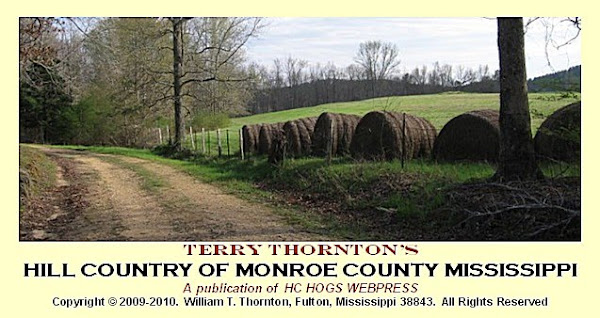[Note: Hill Country is a column from the Monroe Journal, Amory, Mississippi. My articles appear there every other week. After the column appears in MOJO it is then published here on the blog. I am happy to be writing in the newspaper of the Hill Country, the Monroe Journal. Below is the column from March 3, 2010.
AREA ONCE HAD PLENTY OF PIG YOKES
by Terry Thornton
George Spikes, age 25, born in South Carolina, lived in the Richmond area of old Itawamba County in 1860. He was a pig-yoke maker according to the census report of that year.
A pig-yoke is usually defined as three pieces of wood fastened in a triangle round a pig's neck to prevent trespassing through hedges and fences. Cows were also yoked to keep them inside a fence and there are reports of goose-yokes being used to keep geese inside a hedge, fence, or pen.
In the early years of Hill Country before barbed-, hog-, and chicken- wires were available, flocks of cattle, pigs and fowl ran loose. These free-ranging animals were identified by brand or by ear notches or by bells. Foraging on mast in the forest or grazing in open dells and hollows, the animals ran free. When hogs were rounded up and corralled for fattening just before the onset of hog-killing weather, they were often yoked to keep them in their sties
Around most barns were split rail, wattle, or hedge fences (bodock hedges were popular in some locations). Penned animals have a tendency to think the grass is greener on the other side and push through any fence or hedge to start free ranging again.
The loss of animals from fattening pens, sties, or from feed lots around barns was discouraged by using yokes. The Y-shaped yokes of wood about the necks of animals hell-bend on getting out prevented their escape but did not impede their eating or drinking.
Geese and other barnyard fowl wore small, light-weight yokes on their necks to prevent them from pushing through the fence and, of course, clipping their wing-feathers would prevent them flying over it.
In more recent times, I remember cows at Parham wearing yokes to prevent their escape from fenced pastures. Rita Cauthern Thompson of Hatley remembers pig yokes at her grandfather's farm near Pearce Chapel. She says the yokes were "Y" shaped similar to the ones cows wore only smaller. The cow yokes I saw at Parham were fashioned from a sapling which formed a sturdy "Y" shaped growth; the yoke, a single piece of wood, was strapped about the cows head and its shape prevented them from pushing through the fence.
Pig-yokes were not an American invention --- the earlier settlers brought the design to the Colonies. One of the best discussions of the use of pig-yokes is from Manchester, England, circa 1730s as reported at Page 468, The Athenaeum, Number 3024, October 10, 1885:
Pigs must have been a constant source of annoyance, for probably nearly every householder had one or more, and they were frequently not in their sties, but wandering at large in the streets. It was the duty of the swineherd to drive them to feed on the common during the day and bring them home at night. He must have been a man of superhuman patience and tact if he could accomplish his work without impeding the traffic. No pigs were to be driven to Collyhurste --- the common where they grazed --- 'unless they be both yoked and ringed.' We doubt if any of our readers have ever seen a pig wearing a yoke. The practice of using them is fast dying out. The pig yoke was a wooden frame which was fastened around the necks of pigs to hinder them from forcing a way through hedges. They seem to have been object of every-day use. . .
It is not known how many pig-yokes George Spikes made and sold (or bartered) to his neighbors in Itawamba or Monroe County --- but if you have an old animal yoke that is hog-sized, you just might have a Spikes' Pig-Yoke from 1860.
It is believed that Hill Country pig-yoke maker George Spikes, CSA, was killed in 1864 at the battle of Port Hudson, Louisiana.
~~~~~
Terry Thornton is a retired university professor/administrator living in Fulton. Readers may contact him the blog Hill Country HOGS WebPress or email hillcountrymonroecounty@gmail.

No comments:
Post a Comment